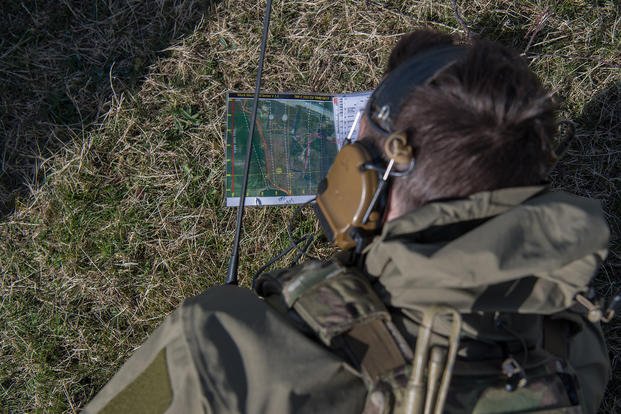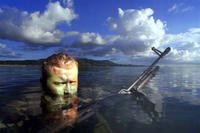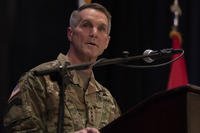Below are the missions and history of the teams that carry out Air Force Special Tactics' primary functions, including combat control, pararescue, special operations weather and tactical air control.
Combat Control
Mission
Air Force Special Operations Command's combat controllers, or CCT, are battlefield airmen assigned to special tactics squadrons. The CCT mission is to deploy undetected into combat and hostile environments to establish assault zones or airfields while simultaneously conducting air traffic control, fire support, command and control, direct action, counterterrorism, foreign internal defense, humanitarian assistance and special reconnaissance.
Motto
Their motto, "First There," reaffirms the combat controller's commitment to undertaking the most dangerous missions behind enemy lines by leading the way for other forces to follow.
History
Army pathfinders originated in 1943 out of need for accurate airdrops during airborne campaigns of World War II. These pathfinders preceded main assault forces into objective areas to provide weather information and visual guidance to inbound aircraft through the use of high-powered lights, flares and smoke pots.
When the Air Force became a separate service, Air Force pathfinders, later called combat control teams, were activated in 1953 to provide navigational aids and air traffic control for a growing Air Force. In the Vietnam War, combat controllers helped assure mission safety and expedited air traffic flow during countless airlifts. Combat controllers also flew as forward air guides in support of indigenous forces in Laos and Cambodia.
Combat controllers continue to be the "First There" when they are called upon to participate in international emergencies and humanitarian relief efforts.
Point of Contact
Air Force Special Operations Command, Public Affairs Office; 229 Cody Ave., Suite 103; Hurlburt Field, FL 32544-5312; DSN 579-5515 or 850-884-5515.
Pararescue
Air Force pararescuemen, also known as PJs, are the only Defense Department elite combat forces specifically organized, trained, equipped and postured to conduct full-spectrum personnel recovery (PR) to include conventional and unconventional combat rescue operations. These battlefield airmen are the most highly trained and versatile personnel recovery specialists in the world. Pararescue is the nation's force of choice to execute the most perilous, demanding and extreme rescue missions anytime, anywhere across the globe. The 500+ PJs are assigned to Guardian Angel and Special Tactics Squadrons throughout the active-duty, Guard and Reserve Air Force components. They operate most often as independent teams but routinely serve alongside other U.S. and Allied Special Operations Forces.
Mission
To rescue, recover, and return American or Allied forces in times of danger or extreme duress. Whether shot down or isolated behind enemy lines; surrounded, engaged, wounded or captured by the enemy; PJs will do whatever is required to deny the enemy a victory and bring our warriors home to fight another day. "Leave no Airman, Marine, Soldier, or Sailor behind" is our nation's supreme promise and responsibility to our brave war fighters. The Air Force holds true to this moral imperative. Personnel recovery is an Air Force core function; one of 12 functions the Air Force provides the nation. The PJs are the elite ground forces that provide our nation with the capability to execute this noble responsibility.
Capabilities
To execute the PR mission, pararescue teams assault, secure and dominate the rescue objective area utilizing any available DoD or Allied air, land or sea asset. Their qualifications and capabilities are extensive. All PJs are qualified experts in advanced weapons and small unit tactics, airborne and military free fall, both High Altitude Low Opening (HALO) and High Altitude High Opening (HAHO) parachute operations, combat divers, high angle/confined space rescue operations, small boat/vehicle craft utilization, rescue swimmers and battlefield trauma/paramedics. All can fast-rope/rappel/hoist from any vertical lift aircraft to land and open ocean rescue objectives. All PJs can perform static-line and HALO jump operations utilizing boats, vehicles or other equipment from any fixed wing aircraft. In addition, one in 12 personnel are tandem jump qualified and can HALO/HAHO both equipment and non-jump personnel into the objective area. As required, all PJs can jump in with and utilize extrication devices to remove war fighters or civilians trapped in wreckage or collapse structures. PJs also utilize the latest subsurface technology to locate and recover submerged equipment or personnel.
Recent History
Since 9/11 alone, these elite warriors have executed more than 12,000 life-saving, combat rescue missions. They've also eliminated and captured numerous enemy combatants during the execution of these missions. Additionally, because of their unique capabilities, they have been called upon to rescue more than 5,000 civilians worldwide during catastrophic natural disasters and other responses.
Decorations
PJs are the most highly decorated Air Force enlisted force. They've been awarded one Medal of Honor, 12 Air Force Crosses and 105 Silver Stars.
Their motto, "These Things We Do, That Others May Live," affirms pararescue's dedication and commitment to saving lives and self-sacrifice. As of January 2012, 10 pararescuemen have been killed in action and paid the ultimate sacrifice during Operation Enduring Freedom and Operation Iraqi Freedom.
Point of Contact
Air Combat Command, Public Affairs Office; 115 Thompson St., Joint Base Langley-Eustis, VA 23665; DSN 574-5007 or 757-764-5007; e-mail: accpa.operations@us.af.mil
Special Operations Weather Team
Special Operations weather team airmen are Air Force meteorologists with unique training to operate in hostile or denied territory. They gather, assess, interpret environmental data and forecast operational impacts from forward deployed locations, working primarily with Air Force and Army Special Operations Forces. They collect critical weather, ocean, river, snow and terrain data, assist mission planning, generate accurate mission-tailored target and route forecasts in support of global special operations and train joint force members and coalition partners to take and communicate limited weather observations. Additionally, Special Operations weathermen conduct environmental special reconnaissance, collect upper air data, organize, establish and maintain weather data reporting networks, determine host-nation meteorological capabilities and train foreign national forces. Every Special Operations Forces mission is planned using the analyses and coordination of special operations weathermen.
History
The U.S. Army Weather Service originated in 1917 to provide the American Expeditionary Forces with "all the meteorological information needed; and to undertake special investigations in military meteorology and related problems". They first took part in World War I combat operations in France in 1918.
During World War II, specially trained weather observers, sometimes referred to as guerrilla weathermen, infiltrated behind enemy lines to provide weather intelligence in support of airstrikes, airlifts and airdrops. In 1947, the Weather Service transferred to the new Air Force with the provision to continue providing meteorological services to the Army. During the Vietnam War, special warfare or commando weathermen provided forward observations and established weather networks in Cambodia and Laos. In every conflict since Vietnam, special operations weathermen were with initial entry forces leading the way, undertaking the most dangerous missions behind enemy lines, conducting austere weather operations and taking observations critical to the success of follow-on forces.
On May 5, 2008, the Air Force approved the establishment of a new Air Force Specialty Code for Special Operations Weather,, formally recognizing their commitment to deploy into restricted environments by air, land or sea to conduct weather operations, observe and analyze all environmental data.
Point of Contact
Air Force Special Operations Command, Public Affairs Office; 229 Cody Ave., Suite 103; Hurlburt Field, FL 32544-5312; DSN 579-5515 or 850-884-5515; e-mail: afsoc.pa@hurlburt.af.mil
Want to Know More About the Military?
Be sure to get the latest news about the U.S. military, as well as critical info about how to join and all the benefits of service. Subscribe to Military.com and receive customized updates delivered straight to your inbox.











